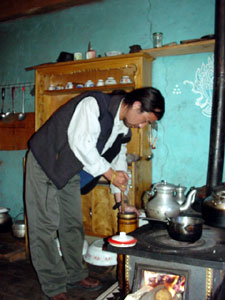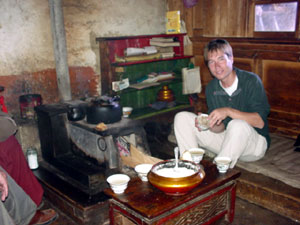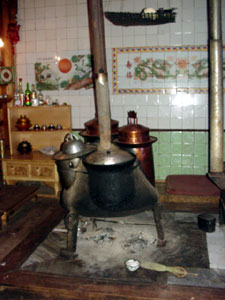![]()
| Yunnan, China | Shangrila & Deqin | 2002.05.16 - 05.23 |
Meeting Tenzin
Several locations in Bhutan, Tibet, Yunnan, and Sichuan informally competed for the title "Shangrila". The Chinese government took a decisive step and changed the name of Zhongdian to Shangrila on 5 May 2002. Unfortunately, the government also tore down the beautiful old Tibetan houses and constructed ugly modern Chinese white-tiled cement blocks throughout the city. After spending millions on a city name change to promote tourism, visitors are likely to be disappointed. To see the Shangrila paradise, multiple-day excursions outside the city are required.
MEETING TENZIN
The highlight of our visit to Shangrila was meeting a man named Tenzin.
Schooled in India under His Holiness the Dalai Lama, Tenzin was given a Buddhist
name Tenzin. For 10 years, a woman in Chasteuil, France sponsored Tenzin's education.
Through this sponsor's friend Nancy (owner of Le Gîte
de Chasteuil), we learned of Tenzin and arranged to meet.
Tenzin is a Tibetan who was born and raised in Zhongdian. At age 11, his father took him to Dharsalama, India for education although he lacked the financial means. Thanks to a French sponsor, Tenzin stayed for 10 years. Upon completing the Tibetan program in India, Tenzin returned to his family in China. Needing Mandarin, he enrolled himself a further 4 years at a Chinese school in Kunming, Yunnan Province's capital. Looking back, Tenzin sees how valuable his experience in India was. Compared to his China educated Tibetan peers, Tenzin has a deeper understanding of Tibetan history, world events, English and Hindi language fluency, and as he puts it, "an open mind." In his opinion, the Chinese education system is ethnocentric, concentrating almost entirely on domestic events and only high-level foreign content. (Sounds like the US public school system, wouldn't you say?) Tenzin is immensely grateful to his sponsor.
Tenzin treated us handsomely as "friends of his sponsor." He went out of his way to give us the best possible experience in Shangrila. On our first full day together, Tenzin took us to the nearby Jongtseling Monastery where, he said, "I have many friends." We attended a monk prayer session, ate sampa (powdered barley) and yak cheese with yak butter tea in the monk's private quarters, met the highest lama of the monastery, and had our Zhi Bead (bought in Lhasa) blessed by a visiting high lama. Another day at Wes' request, Tenzin showed us the construction of a Tibetan house, then asked the owner of the prettiest Tibetan house in the area to let us look inside. All through our monastery and village visits, Tenzin explained the significance of every picture, building material, carved pattern, and social interaction in Tibetan society. We learned more about Tibetan culture in one day with Tenzin than during our week in Tibet!
DEQIN
10 hours bus ride north of Shangrila is Deqin, the last developed town in Yunnan
Province before the Tibetan border. Deqin itself has little of significance but
the surrounding area is a unique biosphere where the Yangzi, Mekong, and Irawaddy
Rivers converge in 3 parallel lines. The 50km distant Minyang Glacier is directly
on the Tibetan border. It holds special interest for climate control scientists and
botanists since the glacier is large and low enough to impact the surrounding
climate. Snow leopards are also thought to live in the area, drawing feline
specialists to investigate. To the common tourist, Minyang Glacier is interesting
in itself. The 7km long trail from the parking lot to viewing platforms adjacent
the icefall takes about 2 hours to ascend and 1 hour to return. Admission is
¥60. Those wishing to avoid this fee can read my entry in the
Travelers Log book at the Dexin Tibetan Hotel in Deqin. The best time to go is
October when the weather is clear and the mountains rise against a blue sky.
In May, we gave up waiting for the weather to clear and ultimately hiked in the rain,
never seeing the mountaintops.
GETTING TO MINYANG GLACIER
A bus runs from Deqin to Minyang daily at 15:00. If you're lucky, the 06:00 bus
from Shangrila will reach Deqin in time for the Minyang bus connection. From
Minyang to Deqin, the bus departs at 08:30. These bus schedules force one or two
overnights in Minyang and one or two overnights in Deqin. If your time is limited,
a taxi can be hired in Deqin for ¥200 round-trip. Compare prices between the
drivers near the Deqin bus station and the owner of Dexin Tibetan Hotel.
 |
Our friend Tenzin has many friends at Songtsenling Monastery located about 10km from Shangrila town center. |
 |
Monks at Songtsenling Monastery descend from their prayers to their residence buildings on the monastery grounds. |
 |
Tenzin makes yak butter tea by mixing yak butter and hot water in a bamboo container. |
 |
Wes tastes monk food in the monk's dining quarters at Songtsenling Monastery. Daily meals consist of yak butter tea (this takes time to get used to), yak cheese (has the consistency of rubber), and sampa (a barley power that sticks in the esophagus like raw dough). In cold climates, this meal warms the body. In a warmer climate, none of this would be considered edible. |
 |
A closer look at Tibetan food: the silver cup holds yak butter tea, and the lacquer bowl has sampa. |
 |
Tenzin asked the owner of the most wealthily decorated Tibetan house near Shangrila to give us access. The unusual wood burning stove in the kitchen heats several pots at once. |
Copyright © 2000-2002 Wes and Masami Heiser. All rights reserved.